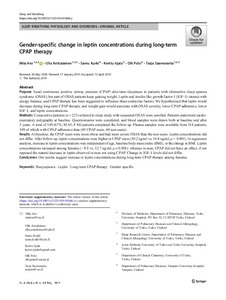Gender-specific change in leptin concentrations during long-term CPAP therapy
Ulla Anttalainen; Samu Kurki; Miia Aro; Kerttu Irjala; Tarja Saaresranta; Olli Polo
https://urn.fi/URN:NBN:fi-fe2021042826702
Tiivistelmä
Purpose
Nasal continuous positive airway pressure (CPAP) alleviates sleepiness in patients with obstructive sleep apnoea syndrome (OSAS), but part of OSAS patients keep gaining weight. Leptin and insulin-like growth factor-1 (IGF-1) interact with energy balance, and CPAP therapy has been suggested to influence these endocrine factors. We hypothesised that leptin would decrease during long-term CPAP therapy, and weight gain would associate with OSAS severity, lower CPAP adherence, lower IGF-1, and leptin concentrations.
Methods
Consecutive patients (n = 223) referred to sleep study with suspected OSAS were enrolled. Patients underwent cardiorespiratory polygraphy at baseline. Questionnaires were completed, and blood samples were drawn both at baseline and after 3 years. A total of 149 (67%; M 65, F 84) patients completed the follow-up. Plasma samples were available from 114 patients, 109 of which with CPAP adherence data (49 CPAP users, 60 non-users).
Results
At baseline, the CPAP users were more obese and had more severe OSAS than the non-users. Leptin concentrations did not differ. After follow-up, leptin concentrations were higher in CPAP users (30.2 ng/ml vs. 16.8 ng/ml; p = 0.001). In regression analysis, increase in leptin concentrations was independent of age, baseline body mass index (BMI), or the change in BMI. Leptin concentrations increased among females (− 8.9 vs. 12.7 ng/ml; p < 0.001); whereas in men, CPAP did not have an effect, if not opposed the natural decrease in leptin observed in men not using CPAP. Change in IGF-1 levels did not differ.
Conclusions
Our results suggest increase in leptin concentrations during long-term CPAP therapy among females.
Kokoelmat
- Rinnakkaistallenteet [19207]
